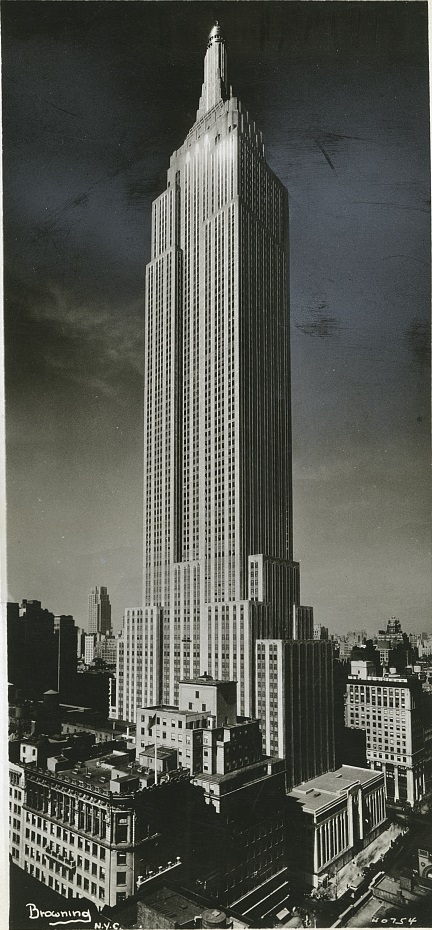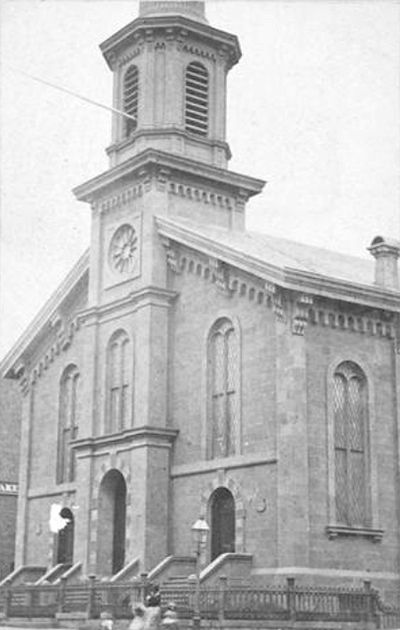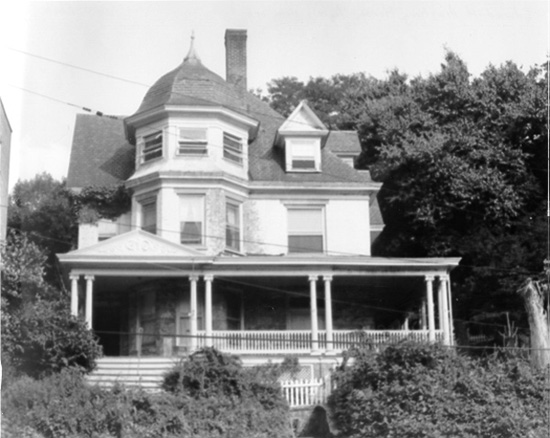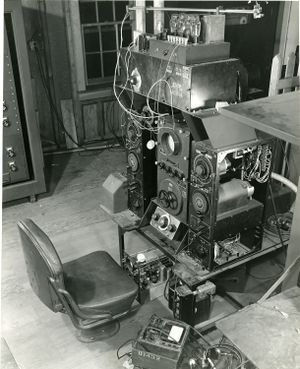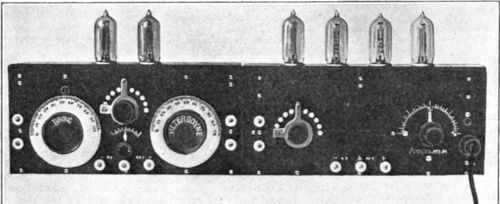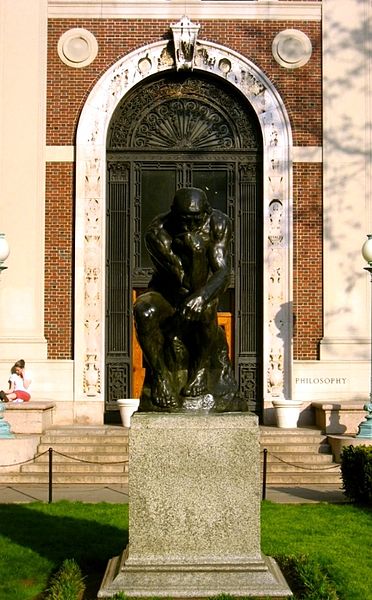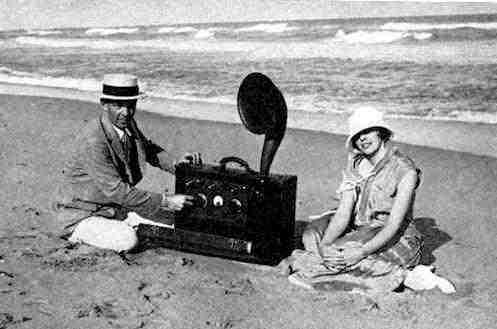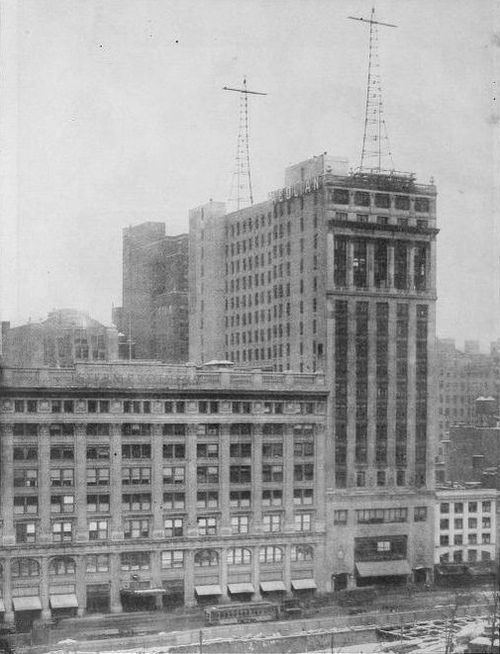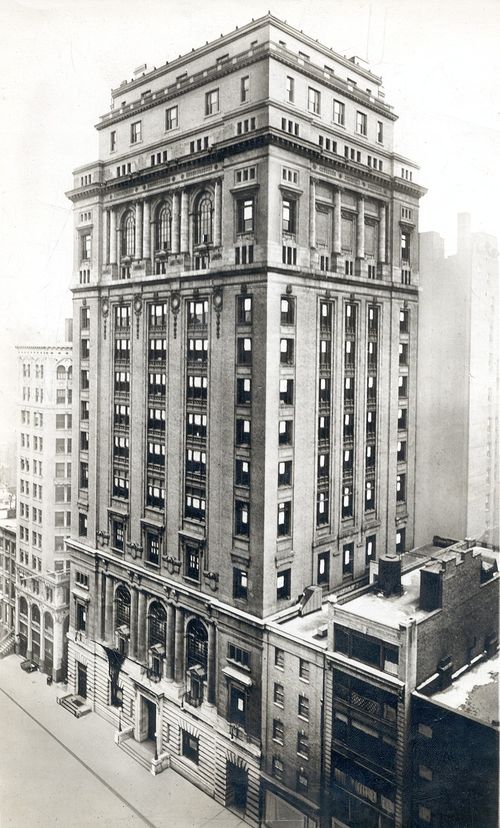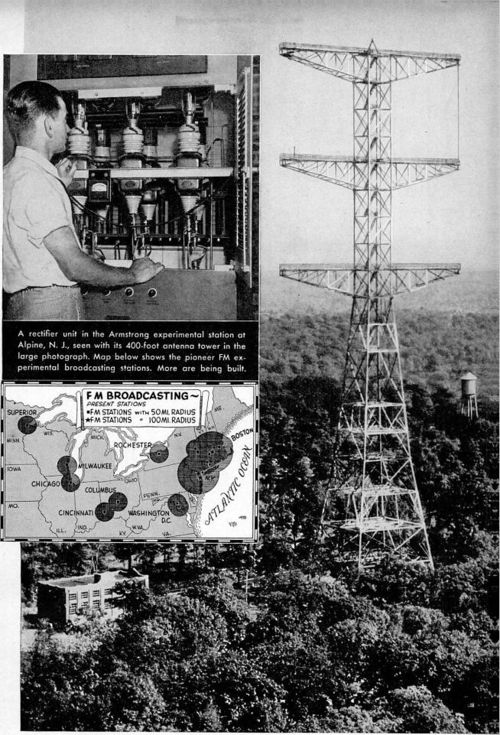Self-Guided tour of sites associated with Edwin Howard Armstrong , wireless and radio pioneer
This tour was researched by Sabin Thapa, Stevens Institute of Technology, and constructed by the staff of the IEEE History Center .
Contents
1 Early Years 2 Radio Towers and Broadcast Locations
2.1 Aeolian Hall (WJZ), 33 West 42nd Street, New York City 2.2 Empire State Building (W2XDG) 2.3 Harry Sadenwater's House, 145 Colonial Ridge Drive, Haddonfield, New Jersey 2.4 Engineering Societies Building, 25-33 West 39th Street, New York City 2.5 Armstrong Tower (W2XMN), Alpine, New Jersey 2.6 Mt. Washington (W1XER), New Hampshire 2.7 Asnebumskit Hill, Paxton, Massachusetts
Early Years Birth at Home Edwin Howard Armstrong was born to Emily and John Armstrong one week before Christmas day, 1890, at their home at 247 West 29th Street in the Chelsea neighborhood of Manhattan, New York City, USA.
Loading map...
{"minzoom":false,"maxzoom":false,"mappingservice":"leaflet","width":"auto","height":"250px","centre":{"text":"","title":"","link":"","lat":40.748482,"lon":-73.993883,"icon":""},"title":"","label":"","icon":"","lines":[],"polygons":[],"circles":[],"rectangles":[],"copycoords":false,"static":false,"zoom":12,"defzoom":14,"layers":["OpenStreetMap"],"image layers":[],"overlays":[],"resizable":false,"fullscreen":false,"scrollwheelzoom":true,"cluster":false,"clustermaxzoom":20,"clusterzoomonclick":true,"clustermaxradius":80,"clusterspiderfy":true,"geojson":"","clicktarget":"","imageLayers":[],"locations":[{"text":"","title":"","link":"","lat":40.748482,"lon":-73.993883,"icon":""}],"imageoverlays":null}
North Presbyterian Church Armstrong's parents and relatives were devout Presbyterians; John and Emily met and were married at North Presbyterian church at 31st Street and 9th Avenue, Manhattan, New York City. With his father as a trustee of the church, Howard and his family attended services here before the property was sold for the construction of the Pennsylvania Railroad's Hudson River tunnel and new train station.
Loading map...
{"minzoom":false,"maxzoom":false,"mappingservice":"leaflet","width":"auto","height":"250px","centre":{"text":"","title":"","link":"","lat":40.734134,"lon":-73.999188,"icon":""},"title":"","label":"","icon":"","lines":[],"polygons":[],"circles":[],"rectangles":[],"copycoords":false,"static":false,"zoom":12,"defzoom":14,"layers":["OpenStreetMap"],"image layers":[],"overlays":[],"resizable":false,"fullscreen":false,"scrollwheelzoom":true,"cluster":false,"clustermaxzoom":20,"clusterzoomonclick":true,"clustermaxradius":80,"clusterspiderfy":true,"geojson":"","clicktarget":"","imageLayers":[],"locations":[{"text":"","title":"","link":"","lat":40.734134,"lon":-73.999188,"icon":""}],"imageoverlays":null}
Armstrong's Second Family Home The Armstrongs moved in 1895 to 26 West 97th Street, New York, NY
Loading map...
{"minzoom":false,"maxzoom":false,"mappingservice":"leaflet","width":"auto","height":"250px","centre":{"text":"","title":"","link":"","lat":40.792549,"lon":-73.9648701,"icon":""},"title":"","label":"","icon":"","lines":[],"polygons":[],"circles":[],"rectangles":[],"copycoords":false,"static":false,"zoom":12,"defzoom":14,"layers":["OpenStreetMap"],"image layers":[],"overlays":[],"resizable":false,"fullscreen":false,"scrollwheelzoom":true,"cluster":false,"clustermaxzoom":20,"clusterzoomonclick":true,"clustermaxradius":80,"clusterspiderfy":true,"geojson":"","clicktarget":"","imageLayers":[],"locations":[{"text":"","title":"","link":"","lat":40.792549,"lon":-73.9648701,"icon":""}],"imageoverlays":null}
Public Grammar School Howard attended grade school on West 89th Street, New York, NY
Loading map...
{"minzoom":false,"maxzoom":false,"mappingservice":"leaflet","width":"auto","height":"250px","centre":{"text":"","title":"","link":"","lat":40.787222,"lon":-73.967927,"icon":""},"title":"","label":"","icon":"","lines":[],"polygons":[],"circles":[],"rectangles":[],"copycoords":false,"static":false,"zoom":12,"defzoom":14,"layers":["OpenStreetMap"],"image layers":[],"overlays":[],"resizable":false,"fullscreen":false,"scrollwheelzoom":true,"cluster":false,"clustermaxzoom":20,"clusterzoomonclick":true,"clustermaxradius":80,"clusterspiderfy":true,"geojson":"","clicktarget":"","imageLayers":[],"locations":[{"text":"","title":"","link":"","lat":40.787222,"lon":-73.967927,"icon":""}],"imageoverlays":null}
Yonkers High School With his physics teacher's permission, Armstrong built a wireless receiver and antenna on top of the school at
150 Rockland Avenue, Yonkers, NY.
Loading map...
{"minzoom":false,"maxzoom":false,"mappingservice":"leaflet","width":"auto","height":"250px","centre":{"text":"","title":"","link":"","lat":40.9265439,"lon":-73.8857365,"icon":""},"title":"","label":"","icon":"","lines":[],"polygons":[],"circles":[],"rectangles":[],"copycoords":false,"static":false,"zoom":12,"defzoom":14,"layers":["OpenStreetMap"],"image layers":[],"overlays":[],"resizable":false,"fullscreen":false,"scrollwheelzoom":true,"cluster":false,"clustermaxzoom":20,"clusterzoomonclick":true,"clustermaxradius":80,"clusterspiderfy":true,"geojson":"","clicktarget":"","imageLayers":[],"locations":[{"text":"","title":"","link":"","lat":40.9265439,"lon":-73.8857365,"icon":""}],"imageoverlays":null}
Runyon's Amateur Radio Station One of Armstrong's earliest and closet childhood friends, Randall "Randy" Runyon, communicated with Armstrong by Morse code. Runyon had built one of the first wireless stations in New York City suburbs.
Loading map...
{"minzoom":false,"maxzoom":false,"mappingservice":"leaflet","width":"auto","height":"250px","centre":{"text":"","title":"","link":"","lat":40.93746,"lon":-73.89599,"icon":""},"title":"","label":"","icon":"","lines":[],"polygons":[],"circles":[],"rectangles":[],"copycoords":false,"static":false,"zoom":12,"defzoom":14,"layers":["OpenStreetMap"],"image layers":[],"overlays":[],"resizable":false,"fullscreen":false,"scrollwheelzoom":true,"cluster":false,"clustermaxzoom":20,"clusterzoomonclick":true,"clustermaxradius":80,"clusterspiderfy":true,"geojson":"","clicktarget":"","imageLayers":[],"locations":[{"text":"","title":"","link":"","lat":40.93746,"lon":-73.89599,"icon":""}],"imageoverlays":null}
1032 Warburton Ave (Regenerative Circuit Invention) Armstrong invented his famous regenerative circuit in 1912 on the third floor under the cupola of his family's home in Yonkers, NY. Designated a National Historic Landmark in 1976, it was demolished after a fire in 1983.
Loading map...
{"minzoom":false,"maxzoom":false,"mappingservice":"leaflet","width":"auto","height":"250px","centre":{"text":"","title":"","link":"","lat":40.9708024,"lon":-73.8888167,"icon":""},"title":"","label":"","icon":"","lines":[],"polygons":[],"circles":[],"rectangles":[],"copycoords":false,"static":false,"zoom":12,"defzoom":14,"layers":["OpenStreetMap"],"image layers":[],"overlays":[],"resizable":false,"fullscreen":false,"scrollwheelzoom":true,"cluster":false,"clustermaxzoom":20,"clusterzoomonclick":true,"clustermaxradius":80,"clusterspiderfy":true,"geojson":"","clicktarget":"","imageLayers":[],"locations":[{"text":"","title":"","link":"","lat":40.9708024,"lon":-73.8888167,"icon":""}],"imageoverlays":null}
Notary Public, Lenox Avenue & West 123rd Street, Manhattan, New York City Armstrong's father refused to give him the $US150 to patent his regenerative circuit. In January 1913, following his uncle Frank Smith's advice to get it notarized, Armstrong, with Columbia engineering classmate Herman Burgi, went to a real estate agent's office and paid 25 cents for the act of witnessing his illustration of the circuit.
Loading map...
{"minzoom":false,"maxzoom":false,"mappingservice":"leaflet","width":"auto","height":"250px","centre":{"text":"","title":"","link":"","lat":40.8065,"lon":-73.94651,"icon":""},"title":"","label":"","icon":"","lines":[],"polygons":[],"circles":[],"rectangles":[],"copycoords":false,"static":false,"zoom":15,"defzoom":14,"layers":["OpenStreetMap"],"image layers":[],"overlays":[],"resizable":false,"fullscreen":false,"scrollwheelzoom":true,"cluster":false,"clustermaxzoom":20,"clusterzoomonclick":true,"clustermaxradius":80,"clusterspiderfy":true,"geojson":"","clicktarget":"","imageLayers":[],"locations":[{"text":"","title":"","link":"","lat":40.8065,"lon":-73.94651,"icon":""}],"imageoverlays":null}
Camp Evans Laboratory (Regenerative Circuit Demo & FM Doppler Radar) After impressing several Marconi Wireless Telegraph Company of America employees with his regenerative amplifier, Armstrong met with the company's chief inspector of the equipment it leased. David Sarnoff brought Armstrong to demonstrate his new regenerative circuit at Camp Evans in Belmar, New Jersey. Together they spent a night receiving and copying Morse code messages from Germany's station in Nauen and American stations on the west coast.
Thirty years later, during World War 2, Armstrong experimented with the use of FM radio for radar purposes under an arrangement with the Signal Corps. He modified an SCR-271 radar and created his experimental FM Doppler radar system, which operated on a narrow receiver bandwidth that was frequency modulated to be in sync with the transmitter. At the end of hostilities, Armstrong left the radar to the military, which modified it for use in Project Diana's "Moon Bounce" in 1946.
Loading map...
{"minzoom":false,"maxzoom":false,"mappingservice":"leaflet","width":"auto","height":"250px","centre":{"text":"","title":"","link":"","lat":40.165212,"lon":-74.082085,"icon":""},"title":"","label":"","icon":"","lines":[],"polygons":[],"circles":[],"rectangles":[],"copycoords":false,"static":false,"zoom":12,"defzoom":14,"layers":["OpenStreetMap"],"image layers":[],"overlays":[],"resizable":false,"fullscreen":false,"scrollwheelzoom":true,"cluster":false,"clustermaxzoom":20,"clusterzoomonclick":true,"clustermaxradius":80,"clusterspiderfy":true,"geojson":"","clicktarget":"","imageLayers":[],"locations":[{"text":"","title":"","link":"","lat":40.165212,"lon":-74.082085,"icon":""}],"imageoverlays":null}
U.S. Army Signal Corps Base in Paris (Superheterodyne Invention) During the First World War, Armstrong was stationed at 140 Boulevard Montparnasse, where the U.S. Army Signal Corps had set up its headquarters. During his service, Armstrong invented the superheterodyne circuit as a result of efforts to intercept high frequency waves coming from approaching German aircraft engines' ignition systems.
Loading map...
{"minzoom":false,"maxzoom":false,"mappingservice":"leaflet","width":"auto","height":"250px","centre":{"text":"","title":"","link":"","lat":48.8408,"lon":2.33255,"icon":""},"title":"","label":"","icon":"","lines":[],"polygons":[],"circles":[],"rectangles":[],"copycoords":false,"static":false,"zoom":12,"defzoom":14,"layers":["OpenStreetMap"],"image layers":[],"overlays":[],"resizable":false,"fullscreen":false,"scrollwheelzoom":true,"cluster":false,"clustermaxzoom":20,"clusterzoomonclick":true,"clustermaxradius":80,"clusterspiderfy":true,"geojson":"","clicktarget":"","imageLayers":[],"locations":[{"text":"","title":"","link":"","lat":48.8408,"lon":2.33255,"icon":""}],"imageoverlays":null}
Later Years Philosophy Hall, Columbia At Columbia University, Armstrong worked closely with mentor and friend, Professor Michael Pupin, to continue his work at Columbia University in the Department of Electrical Engineering after graduation in 1912.
Loading map...
{"minzoom":false,"maxzoom":false,"mappingservice":"leaflet","width":"auto","height":"250px","centre":{"text":"","title":"","link":"","lat":40.8079965,"lon":-73.9639283,"icon":""},"title":"","label":"","icon":"","lines":[],"polygons":[],"circles":[],"rectangles":[],"copycoords":false,"static":false,"zoom":12,"defzoom":14,"layers":["OpenStreetMap"],"image layers":[],"overlays":[],"resizable":false,"fullscreen":false,"scrollwheelzoom":true,"cluster":false,"clustermaxzoom":20,"clusterzoomonclick":true,"clustermaxradius":80,"clusterspiderfy":true,"geojson":"","clicktarget":"","imageLayers":[],"locations":[{"text":"","title":"","link":"","lat":40.8079965,"lon":-73.9639283,"icon":""}],"imageoverlays":null}
West Palm Beach, Florida The major and his newlywed wife, Esther Marion MacInnis Armstrong, took a honeymoon roadtrip in 1923 to Palm Beach, Florida, in which Armstrong gifted her his new portable superheterodyne receiver.
Loading map...
{"minzoom":false,"maxzoom":false,"mappingservice":"leaflet","width":"auto","height":"250px","centre":{"text":"","title":"","link":"","lat":26.714382,"lon":-80.054285,"icon":""},"title":"","label":"","icon":"","lines":[],"polygons":[],"circles":[],"rectangles":[],"copycoords":false,"static":false,"zoom":12,"defzoom":14,"layers":["OpenStreetMap"],"image layers":[],"overlays":[],"resizable":false,"fullscreen":false,"scrollwheelzoom":true,"cluster":false,"clustermaxzoom":20,"clusterzoomonclick":true,"clustermaxradius":80,"clusterspiderfy":true,"geojson":"","clicktarget":"","imageLayers":[],"locations":[{"text":"","title":"","link":"","lat":26.714382,"lon":-80.054285,"icon":""}],"imageoverlays":null}
Randy Runyon's Home Loading map...
{"minzoom":false,"maxzoom":false,"mappingservice":"leaflet","width":"auto","height":"250px","centre":{"text":"","title":"","link":"","lat":40.95323,"lon":-73.88972,"icon":""},"title":"","label":"","icon":"","lines":[],"polygons":[],"circles":[],"rectangles":[],"copycoords":false,"static":false,"zoom":12,"defzoom":14,"layers":["OpenStreetMap"],"image layers":[],"overlays":[],"resizable":false,"fullscreen":false,"scrollwheelzoom":true,"cluster":false,"clustermaxzoom":20,"clusterzoomonclick":true,"clustermaxradius":80,"clusterspiderfy":true,"geojson":"","clicktarget":"","imageLayers":[],"locations":[{"text":"","title":"","link":"","lat":40.95323,"lon":-73.88972,"icon":""}],"imageoverlays":null}
Marconi Wireless Hut, Rocky Point, New York Edwin Armstrong purchased this building as the earliest known radio station in 1933 and gifted it to David Sarnoff for RCA.
Loading map...
{"minzoom":false,"maxzoom":false,"mappingservice":"leaflet","width":"auto","height":"250px","centre":{"text":"","title":"","link":"","lat":40.95256,"lon":-72.92504,"icon":""},"title":"","label":"","icon":"","lines":[],"polygons":[],"circles":[],"rectangles":[],"copycoords":false,"static":false,"zoom":12,"defzoom":14,"layers":["OpenStreetMap"],"image layers":[],"overlays":[],"resizable":false,"fullscreen":false,"scrollwheelzoom":true,"cluster":false,"clustermaxzoom":20,"clusterzoomonclick":true,"clustermaxradius":80,"clusterspiderfy":true,"geojson":"","clicktarget":"","imageLayers":[],"locations":[{"text":"","title":"","link":"","lat":40.95256,"lon":-72.92504,"icon":""}],"imageoverlays":null}
Radio Towers and Broadcast Locations Aeolian Hall (WJZ), 33 West 42nd Street, New York City
In 1923, Armstrong climbed the top of one of RCA's transmitting towers and had George Burghard photograph him.
Loading map...
{"minzoom":false,"maxzoom":false,"mappingservice":"leaflet","width":"auto","height":"250px","centre":{"text":"","title":"","link":"","lat":40.75441,"lon":-73.98321,"icon":""},"title":"","label":"","icon":"","lines":[],"polygons":[],"circles":[],"rectangles":[],"copycoords":false,"static":false,"zoom":12,"defzoom":14,"layers":["OpenStreetMap"],"image layers":[],"overlays":[],"resizable":false,"fullscreen":false,"scrollwheelzoom":true,"cluster":false,"clustermaxzoom":20,"clusterzoomonclick":true,"clustermaxradius":80,"clusterspiderfy":true,"geojson":"","clicktarget":"","imageLayers":[],"locations":[{"text":"","title":"","link":"","lat":40.75441,"lon":-73.98321,"icon":""}],"imageoverlays":null}
Empire State Building (W2XDG) Armstrong conducted FM radio tests through RCA's experimental radio station on the Empire State Building from 1934-1935.
Loading map...
{"minzoom":false,"maxzoom":false,"mappingservice":"leaflet","width":"auto","height":"250px","centre":{"text":"","title":"","link":"","lat":40.748479,"lon":-73.985411,"icon":""},"title":"","label":"","icon":"","lines":[],"polygons":[],"circles":[],"rectangles":[],"copycoords":false,"static":false,"zoom":12,"defzoom":14,"layers":["OpenStreetMap"],"image layers":[],"overlays":[],"resizable":false,"fullscreen":false,"scrollwheelzoom":true,"cluster":false,"clustermaxzoom":20,"clusterzoomonclick":true,"clustermaxradius":80,"clusterspiderfy":true,"geojson":"","clicktarget":"","imageLayers":[],"locations":[{"text":"","title":"","link":"","lat":40.748479,"lon":-73.985411,"icon":""}],"imageoverlays":null}
Harry Sadenwater's House, 145 Colonial Ridge Drive, Haddonfield, New Jersey Henry Sadenwater and George E. Burghard offered to set up receiving antennas in their homes east and south of Armstrong's FM transmitters in Manhattan, New York City. Burghard's summer house was located in Westhampton Beach before it was destroyed in the Hurricane of 1938, and Sadenwater lived in Haddonfield, New Jersey.
Loading map...
{"minzoom":false,"maxzoom":false,"mappingservice":"leaflet","width":"auto","height":"250px","centre":{"text":"","title":"","link":"","lat":39.8828,"lon":-75.03522,"icon":""},"title":"","label":"","icon":"","lines":[],"polygons":[],"circles":[],"rectangles":[],"copycoords":false,"static":false,"zoom":12,"defzoom":14,"layers":["OpenStreetMap"],"image layers":[],"overlays":[],"resizable":false,"fullscreen":false,"scrollwheelzoom":true,"cluster":false,"clustermaxzoom":20,"clusterzoomonclick":true,"clustermaxradius":80,"clusterspiderfy":true,"geojson":"","clicktarget":"","imageLayers":[],"locations":[{"text":"","title":"","link":"","lat":39.8828,"lon":-75.03522,"icon":""}],"imageoverlays":null}
Engineering Societies Building, 25-33 West 39th Street, New York City Armstrong gave his first public demonstration of frequency modulated radio here on 6 November 1935.
The Engineering Societies Building at 29 West 39th St, completed in 1906.
Loading map...
{"minzoom":false,"maxzoom":false,"mappingservice":"leaflet","width":"auto","height":"250px","centre":{"text":"","title":"","link":"","lat":40.75244,"lon":-73.98444,"icon":""},"title":"","label":"","icon":"","lines":[],"polygons":[],"circles":[],"rectangles":[],"copycoords":false,"static":false,"zoom":12,"defzoom":14,"layers":["OpenStreetMap"],"image layers":[],"overlays":[],"resizable":false,"fullscreen":false,"scrollwheelzoom":true,"cluster":false,"clustermaxzoom":20,"clusterzoomonclick":true,"clustermaxradius":80,"clusterspiderfy":true,"geojson":"","clicktarget":"","imageLayers":[],"locations":[{"text":"","title":"","link":"","lat":40.75244,"lon":-73.98444,"icon":""}],"imageoverlays":null}
Armstrong Tower (W2XMN), Alpine, New Jersey
After the Empire State Building tests ended in 1938, Armstrong funded the construction of a transmitter building and 400-foot tower for his experimental FM radio station in Alpine, New Jersey.
Loading map...
{"minzoom":false,"maxzoom":false,"mappingservice":"leaflet","width":"auto","height":"250px","centre":{"text":"","title":"","link":"","lat":40.941279,"lon":-73.924215,"icon":""},"title":"","label":"","icon":"","lines":[],"polygons":[],"circles":[],"rectangles":[],"copycoords":false,"static":false,"zoom":12,"defzoom":14,"layers":["OpenStreetMap"],"image layers":[],"overlays":[],"resizable":false,"fullscreen":false,"scrollwheelzoom":true,"cluster":false,"clustermaxzoom":20,"clusterzoomonclick":true,"clustermaxradius":80,"clusterspiderfy":true,"geojson":"","clicktarget":"","imageLayers":[],"locations":[{"text":"","title":"","link":"","lat":40.941279,"lon":-73.924215,"icon":""}],"imageoverlays":null}
Mt. Washington (W1XER), New Hampshire John Shephard III, owner of the Yankee Network in New England, USA, was, impressed with Armstrong's FM work. He arranged for construction of FM stations to relay broadcast programs from one station to another via the Yankee Network's station and antenna on Mount Washington in 1940.
Visit the U.S. National Archives for pictures of Armstrong on Mt. Washington .
Loading map...
{"minzoom":false,"maxzoom":false,"mappingservice":"leaflet","width":"auto","height":"250px","centre":{"text":"","title":"","link":"","lat":38.048168,"lon":-85.541679,"icon":""},"title":"","label":"","icon":"","lines":[],"polygons":[],"circles":[],"rectangles":[],"copycoords":false,"static":false,"zoom":12,"defzoom":14,"layers":["OpenStreetMap"],"image layers":[],"overlays":[],"resizable":false,"fullscreen":false,"scrollwheelzoom":true,"cluster":false,"clustermaxzoom":20,"clusterzoomonclick":true,"clustermaxradius":80,"clusterspiderfy":true,"geojson":"","clicktarget":"","imageLayers":[],"locations":[{"text":"","title":"","link":"","lat":38.048168,"lon":-85.541679,"icon":""}],"imageoverlays":null}
Asnebumskit Hill, Paxton, Massachusetts Loading map...
{"minzoom":false,"maxzoom":false,"mappingservice":"leaflet","width":"auto","height":"250px","centre":{"text":"","title":"","link":"","lat":42.30715,"lon":-71.90137,"icon":""},"title":"","label":"","icon":"","lines":[],"polygons":[],"circles":[],"rectangles":[],"copycoords":false,"static":false,"zoom":12,"defzoom":14,"layers":["OpenStreetMap"],"image layers":[],"overlays":[],"resizable":false,"fullscreen":false,"scrollwheelzoom":true,"cluster":false,"clustermaxzoom":20,"clusterzoomonclick":true,"clustermaxradius":80,"clusterspiderfy":true,"geojson":"","clicktarget":"","imageLayers":[],"locations":[{"text":"","title":"","link":"","lat":42.30715,"lon":-71.90137,"icon":""}],"imageoverlays":null}
Loading map...
{"minzoom":false,"maxzoom":false,"mappingservice":"leaflet","width":"auto","height":"250px","centre":{"text":"","title":"","link":"","lat":40.792549,"lon":-73.9648701,"icon":""},"title":"","label":"","icon":"","lines":[],"polygons":[],"circles":[],"rectangles":[],"copycoords":false,"static":false,"zoom":12,"defzoom":14,"layers":["OpenStreetMap"],"image layers":[],"overlays":[],"resizable":false,"fullscreen":false,"scrollwheelzoom":true,"cluster":false,"clustermaxzoom":20,"clusterzoomonclick":true,"clustermaxradius":80,"clusterspiderfy":true,"geojson":"","clicktarget":"","imageLayers":[],"locations":[{"text":"","title":"","link":"","lat":40.792549,"lon":-73.9648701,"icon":""}],"imageoverlays":null}
For a list of other Technical History Tours, please click here .
